#fyn denmark
Text

Egeskov castle. Fyn, Denmark.
#egeskov castle#fyn#funen#denmark#egeskov slot#the southern isles#frozen fever#frozen#frozen disney#hans#prince hans#hans frozen#who is this hans?#my theories#the 13th is out
23 notes
·
View notes
Text




long train ride this morning, actually focused and wrote without stopping like that montage in bruce almighty. 😎 Got a lot of good career news this week plus finished a big tv show plus didn't sleep.. all this to say I cried in public obviously
7 notes
·
View notes
Photo

#stefanhaehnel#cycling#long distance#hovedting#denmark#winter#bikepacking#cicli bonanno#gramm tourpacking#fyns hoved
6 notes
·
View notes
Text

Brahetrolle Castle, Fyn Island, Denmark
Danish vintage postcard
#denmark#sepia#photography#vintage#brahetrolle#castle#postkaart#ansichtskarte#ephemera#carte postale#postcard#postal#briefkaart#fyn island#photo#brahetrolle castle#danish#island#tarjeta#historic#postkarte
1 note
·
View note
Text






0 notes
Text


Giant Viking Runestone Found Under kitchen Floor in Denmark
A Couple Renovating Their Kitchen in Denmark Found an Ancient Stone Carved With Viking Runes
The stone may be one of the oldest and rarest of its kind, and is now being studied by experts.
When Lene Brandt and her husband, Anders Nielsen, were preparing to tear up the linoleum floors in the kitchen in their home in the village of Mosekær, in Denmark, they probably expected the normal things that occur in the course of such a project: cost overruns, delays, and problems with contractors.

Instead, what they found was an ancient artifact. The couple stumbled across a nearly 2,000-pound stone, measuring more than six feet long, carved with ancient runes. The couple contacted local experts at the Museum Østjylland. Staff archaeologist Benita Clemmensen is quoted by the cultural news site Skjalden saying that these stones are the sole written records of the Viking Age.
Five runes can be found carved into the stone’s surface, reading “aft Bi,” which can be translated as “after B.”

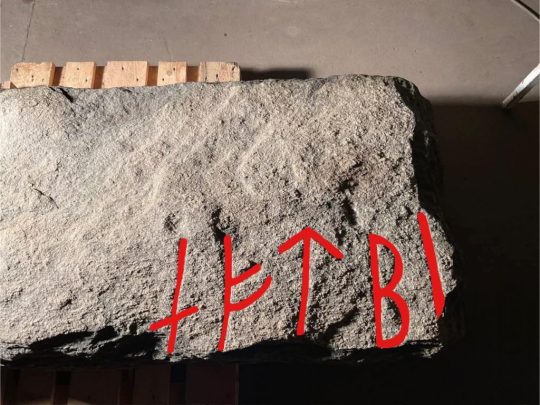
“The Mosekær stone is probably to be dated to the eighth or nineth century because of the formula ‘After… ‘, i.e. ‘In memory of’, placed in the beginning of the text,” senior researcher and runologist Lisbeth Imer, with the National Museum of Denmark, Copenhagen, tells Artnet News. “It correlates with an eighth-century runestone on Fyn, the Flemløse stone with the text ‘After Hróðulfr stands this stone; he was… priest/chief. Sons placed in memory. Ávarr coloured.’
“It most likely is one of the oldest runestones in Denmark,” she says.
The museum has dubbed the stone a treasure, meaning it legally belongs to the state.
New rune stones are found only every five or 10 years, Imer says, “so it is a rare find.”
Imer tells Skjalden that only about 20 rune stones from the eighth century have been discovered in Denmark. These early stones are very significant, as there are approximately 200 known Viking Age rune stones (dating from the 700s to the 900s) throughout the country. Norse literature is dense with references to runes, which may have served as magical signs to be used in charms.
The area where this rune stone was found has proven particularly rich for archaeologists, yielding some 44 such artifacts.

#Giant Viking Runestone Found Under kitchen Floor in Denmark#vikings#runestones#ancient artifact#archeology#archeolgst#history#history news#ancient history#ancient culture#ancient civilizations#viking age#viking history
255 notes
·
View notes
Photo



Crown Princess Mary participate in a One Mile during the Royal Run event in Nyborg, on the island of Fyn, Denmark | May 29, 2023
#royaltyedit#theroyalsandi#crown princess mary#mary donaldson#danish royal family#my edit#royalrun2023
59 notes
·
View notes
Photo




Through the Years → Mary, Crown Princess of Denmark (764/∞)
29 May 2023 | Denmark's Crown Princess Mary participates in a 'one mile' competition during the Royal Run event in Nyborg, on the island of Fyn, Denmark. (Photo by Tim Kildeborg Jensen/Ritzau Scanpix/AFP via Getty Images)
#Queen Mary#Denmark#2023#Tim Kildeborg Jensen#Ritzau Scanpix#AFP via Getty Images#through the years: Mary
18 notes
·
View notes
Text
This is an overhaul of an old post from 5 years ago, because I've added a bunch of stuff which unfortunately does not show up correctly anywhere but ON my blog.
Denmark, Scandinavia, and the Nordic region in Danish
Areas
The Nordic countries - De nordiske lande · Norden
Scandinavia - Skandinavien
Kingdom of Denmark · Danish Realm - Kongeriget Danmark · Danmarks Rige
The Kalmar Union · Union of Kalmaris - Kalmarunionen (1397 to 1523)
Countries
Denmark - Danmark
Sweden - Sverige
Norway - Norge
Finland - Finland
Greenland - Grønland · Kalaallit Nunaat (Greenlandic, lit. “Greenlanders’ land")
The Faroe Islands - Færøerne · Føroyar (Faroese)
Iceland - Island
Languages
Danish - dansk
Swedish - svensk
Norwegian - norsk · nynorsk · norsk bokmål
Finnish - finsk
(West) Greenlandic - (vest)grønlandsk · kalaallisut
Faroese - færøsk · føroyskt
Icelandic - islandsk
Minority languages
German - tysk (spoken by the German minority in North Schleswig/South Jutland)
Sámi - samisk (spoken by the Sámi people in large parts of northern Finland, Norway, and Sweden; the cultural region of Sápmi)¹
Inuktun · Polar Inuit - nordgrønlandsk · avanersuarmiutut (spoken in Northern Greenland, around Qaanaaq)²
East Greenlandic - østgrønlandsk · tunumiisut (spoken in Eastern Greenland/Tunu)²
Romani - romani (spoken by the Romani people)
Kven - kvensk (spoken by the Kven people in northern Norway)³
Sign Language - tegnsprog⁴
National demonyms⁵
Dane - dansker
Swede - svensker
Norwegian - nordmand (lit. “northern man”)
Finn - finne · finlænder (rare)
Greenlander - grønlænder · kalaaleq
Faroese · Faroe islander - færing · føroyingur
Icelander - islænding
German - tysker
Non-national ethnicities
Romani - romani
Sámi - same
Specifically Danish stuff
Places in Denmark⁶
Copenhagen - København
Aarhus - Aarhus · Århus (unofficial, but not incorrect spelling)
Jutland - Jylland · Hovedlandet (slang)
Funen - Fyn
Zealand - Sjælland · Djævleøen (slang, lit. “The Devil’s Island”)
Major dialects/regiolects based on location
Jutland - jysk
Zealand - sjællandsk
Funen - fynsk
Bornholm - bornholmsk
All islands (including Zealand + Funen, excluding Bornholm) - ømål (lit. “island language”)
Smaller areas that used to be Denmark
Schleswig-Holstein - Slesvig-Holsten⁷
Scania (Skånes län) - Skåne (around 970 to 1658)
Halland (Hallands län) - Halland (around 970 to 1645, legally 1658)
Blekinge (Blekinge län) - Blekinge (around 970 to 1658)
The Virgin Islands of the United States - Jomfruøerne · Dansk-Vestindien (outdated) · De Vestindiske Øer (outdated) (1672 to 1917)
Estonia - Estland (Hertugdømmet Estland 1206 to 1346, Øsel 1560 to 1645)⁸
Notes:
1) There are many Sámi languages and dialects, too many to list here.
2) Some argue that East and West Greenlandic are dialects of the same language and that North Greenlandic (Inuktun) is a dialect of Inuktitut.
3) Some do not recognise Kven as a separate language from Finnish.
4) Obviously, there is not 1 (one) Sign Language in the entire Nordic. There are Danish, Norwegian, and Icelandic Sign (which are all related), and Swedish and Finnish Sign (which are related to each other). Danish Sign is also used in Greenland and the Faroe Islands.
5) All nationalities and ethnicities fælleskøn (utrum)/common gender (uter).
6) These are just the major parts that you probably should know
7) The whole Schleswig-Holstein area has been much disputed and is hard to date. It was definitely NOT part of Denmark 1864-1920.
8) All of Estonia was never Danish, but various parts were.
If I screwed up or you have questions, feel free to shoot me a message!
#denmark#scandinavia#the nordic region#nordic countries#danish#langblr#language#dansk#danish vocabulary#original#in case you were wondering what was added#the answer is a BUNCH of minority languages#MORE notes#and numbers to the notes for your convenience
12 notes
·
View notes
Text
The 13th post: More than a Disney Prince
“Hans is a prince. He is a Disney Prince, but he’s more than a Disney Prince. He is many things. And there are a lots of secrets and twists and turns that we take with Hans.”
"A lot of the scenes I recorded did not end up in the movie"
Santino Fontana on Hans.
From Admiral Westergaard to Prince Hans of the Southern Isles
As you will already know, Frozen is an adaptation from the tale “The Snow Queen” by danish author Hans Christian Andersen. Disney had been trying to adapt “The Snow Queen” for decades. Different ideas were developed and a lot of changes were made in the process (you have a really interesting post about Frozen’s development by @greatqueenanna here).
We know that at some point, when Elsa still was a villain, the idea for Hans’ character was a nameless “Admiral Westergaard”, who was Anna’s love interest.
Evil Elsa deleted scene
Elsa was then changed, from a villain to a villain who had a redemption thanks to Anna, while Admiral Westergaard became a surprise villain.
Fast-forward to the final act: Elsa creates an army of snow monsters to attack our heroes while Kristoff has “a Han Solo moment” and comes to help Anna. To halt Elsa’s attacking army, the two-faced Prince Hans triggers a massive avalanche — not caring that the avalanche also puts Anna, Elsa and all of Arendelle in jeopardy. Anna realizes Elsa is their only hope, so she convinces her to use her powers to save the kingdom (...) Elsa’s heart is then unfrozen allowing her to love again.
At some point, Admiral Westergaard was changed to Prince Hans of the Southern Isles. This is a strange change for a villanous character if you ask me: they not only made him a Disney prince by birth, but also gave him the first name of the author of the original tale. Besides, keeping in mind that the names of the main characters in Frozen are meant to be a Hans Christian Andersen reference (Hans Kristoff Anna Sven), prince Hans would somehow be the most important, because he’s the one who was given the author’s first name. Makes sense, doesn't it?
Oh, but maybe it's just a coincidence.
Besides this, there is the fact that the kingdom’s name, Arendelle, is based in the norwegian town of Arendal. The isles located south of Arendal are, in real life, Denmark. And Hans Christian Andersen was danish. So they gave prince Hans not only the name but also the nationality of the author.
Also a coincidence?
Disney gave us a huge, very important clue with the Frozen Fever map.

This picture was originally posted by @wrath-of-zirro. A lot to analyze here.
On the top left corner there is a map of real Arendall with Denmark on the south; and the Frozen Fever map on the right. It is clear "The Southern Isles" are the danish isles of Fyn and its surroundings.
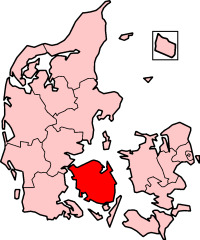
Map of real life Denmark with Fyn (Funen) in red from Wikipedia. Compare to The Southern Isles in the Frozen Fever map.
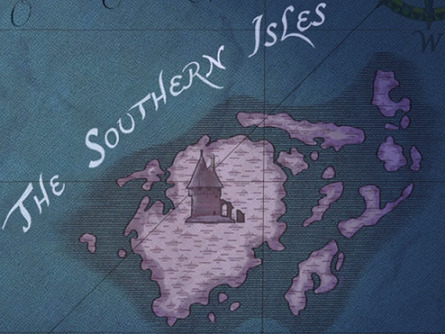
Hans Christian Andersen was born in Odense, capital city of Fyn.
In the bottom of the picture we see the Egeskov Castle in Fyn, whose tower reminds of the one we see in The Southern Isles in the Frozen Fever map. It looks like it the castle was still under construction in the Frozen Fever map (there are 13 princes, so they need a huge castle I guess!). It's quite hard to me to think all of this is just a coincidence.
But that is not the only Andersen reference. Hans having twelve older brothers reminds of Andersen's tale The Wild Swans. That tale is about a princess who has eleven older brothers. The princess is named Eliza, which reminds of Elsa and, not unlike her, she is taken for a witch and is almost killed for that reason.
It is also known that Disney planned to make a movie about the danish author's life which started developing in the 1940s (the same time period in which they started trying to adapt The Snow Queen).
That project was later abandoned. Nevertheless, Disney has adapted many of the danish author's tales.
So... could it be that when Frozen was finally made, the creators decided to pay homage to the danish author by making him a Disney Prince?
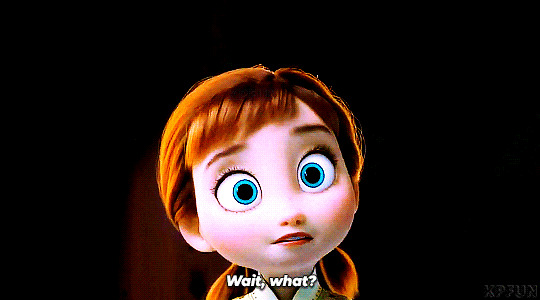
But wait... there is more.
Thanks to @thelittlehansy I knew Hans Christian Andersen himself appeared as an animated character in an episode of The Little Mermaid animated series, called "Metal Fish". So, if Disney already had an animated character design for H.C. Andersen, and Prince Hans was a tribute to the author, it would make sense they would look alike, wouldn't it? They just had to redesign the character to make him look young, regal and handsome. Let's have a look at how did the animated version of the danish author look like. I found the episode in swedish language on Youtube:
Part 1
Part 2


They look pretty similar to me. Ginger, big nose, large chin, with sideburns, wears a vest and, in the last scene, a tailcoat. Even the fringe is similar. If you still think all of this is a coincidence I have to disagree. As the Duke would say: The can be no doubt now.
Frozen Fandom: But that's not posible! Making the author a villain, not very important for the story, and the center of silly jokes?! That would be so disrespectful!
Well, I have spent two years trying to prove Frozen makes perfect sense withouth Hans being a bad guy. Santino Fontana said a lot of the scenes he recorded weren't finally included in the movie, so it's safe to think we miss a lot of information about the character. The movie is not badly written; it's too well written in fact: the plotholes are part of the plot.
Frozen Fandom: But Hans is the villain!! He plotted a whole plan to take over the kingdom, took advantage of Anna's vulnerability, leave her to die when she needed him the most and let's not forget almost decapitate Elsa after lying to her about her sister's death.
*Sighs in frustration* All you can accuse Hans of is being a jerk to a dying Anna, being in a very stressfull, life-or-death situation. But let's deny these accusations one by one.
Lying to Elsa about Anna's death: Technically, he wasn't lying, as Anna was dying because of ice magic and Hans though (because of Anna's own words!) Elsa willingly attacked her.
Almost decapitated Elsa: Already explained in the 11th post of this analysis.
Leave Anna to die: Hans was sure there was nothing he - or anyone else - could make to save Anna, and let's not forget the overall situation: people in the kingdom was in inminent risk of dying because of the winter (remember the Duke's words: if we don't "do something" ( = kill Elsa) soon, we all will freeze to death), and he was really shocked (see 9th post of this analysis) to know Elsa had attacked Anna.


Plotted a whole plan to take over the kingdom: The only evidence for this is his own "villain monologue", which I don't think we should take seriously for reasons already explained in the 9th and 12th posts. Telling Anna he wanted to marry her and then arrange "a little accident" of Elsa is more him being a jerk than confessing an evil scheme.
Took advantage of Anna's vulnerability: I have to disagree. I think he manipulated her a bit, but not all of the time. If we look at their "date" from an objective point of view, we realize that for the most part he was just being friendly. Dancing, taking a walk, eating something is not something particularly romantic.
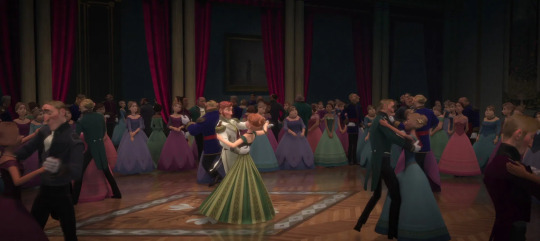
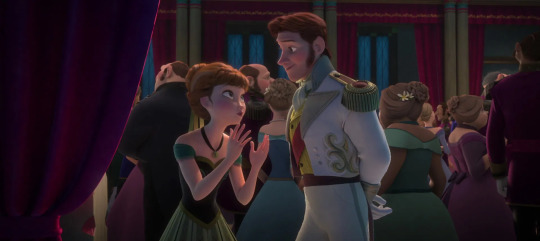
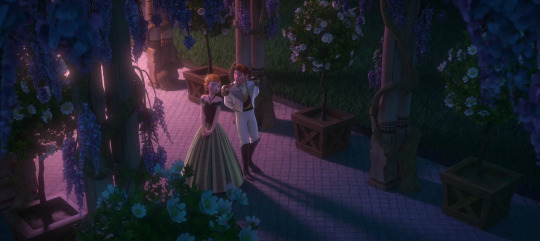
There were not ardent love expressions, he didn't even tell Anna he loved her. Can we really say he "seduced" her? The shoulder bump is romantic? It's more a friendly gesture, that is coded later in the saga as a "sibling thing".
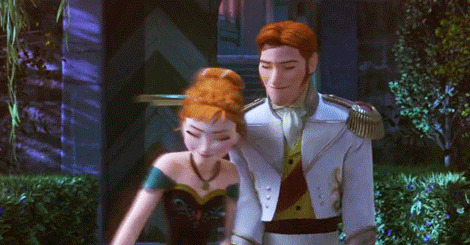
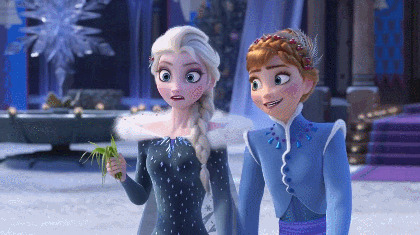
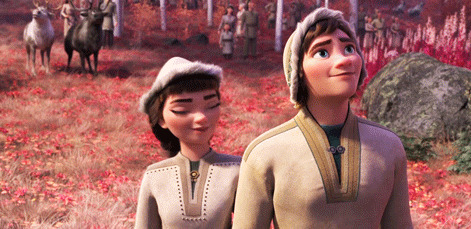
We are led to see the scene in a subjective way, through Anna's eyes. But if we rewacht the scene from an objective point of view, all we see is a friendly interaction.Things don't get really "romantic" until "Love is an Open Door". And let's not forget it's Anna who begins it and this is Hans' first reaction:

Then he basically plays along with her, and at the end of the song - when he proposes to her - that's where the manipulation begins.
Another reason against Hans being a villain would be his facial expressions. He only has facial expressions that could be labeled as villainous in a few scenes (already explained in previous posts). I find it very telling that when he sentences Elsa to death, creators chose to give us a close-up of his face expressing sadness - when a smirk would be more fitting, since this happens after the betrayal scene. It's like they wanted to tell the audience: "No, Hans is not happy to sentence Elsa to death; he is devastated".


Frozen Fandom: He`s faking to the Duke and the dignataries.
It could be, but it's unusual for Disney characters to fake to the audience. Gaston makes villanous expressions since he first appears, so the audience can easily identify him as a villain... but everyone in the town think he's a great guy!
And Mother Gothel... think how interesting would it be if the audience wasn't given the backstory at the beginning of Tangled. But still in that case, we would be able to analize her expressions and realize they are different from those of a worried parent.


Frozen Fandom: well, so who do you think is the villain then?
Simple: there is no real villain in Frozen. But there are two fake villains. This pair.

Before we continue we have to make the following question: who is this Elsa?
But was she the cursed princess to be saved, or the wicked witch to be vanquished? And what was his role in this story? (A particular understanding, by @fasadi)
Elsa: A witch in distress
While most of the audience identifies Elsa as a princess, making Frozen a "two princesses movie", this is only half truth. Anna is "the princess" and real protagonist in Frozen, while her sister shares some traits with other kind of classic Disney characters. Let's see: Elsa...
Is older than the princess
Has magical powers
Lives isolated
Has a position of power (she's the princess heir and becomes the Queen)
Wears heavy make up
Wears purple clothes (her coronation cape) and uses purple eyeshadow
Curses the princess and the kingdom
Her actions have a huge impact on the plot
Has a great (villain) song
Is (almost) killed by the prince
The 13th Disney princess shares these characteristics with these ladies:

From my point of view, the Evil Queen from Snow White is the one that has had the biggest influence in Elsa's look. I found the following description of the Evil Queen on the Disney fandom wiki very fitting for Elsa:
"From the outside, the Queen appears to be calm, regal, and sophisticated, but in reality, this collected and stately facade hides an extremely sadistic, hateful, cold and sinister person" (Elsa's facade is similar and also hides her real self)
"The Queen is an icily beautiful woman with a serene, unfeeling face and a slender figure. She has pale skin, red lips, green eyes, and seemingly penciled-on eyebrows"


They both wear a long cape with a pendant. You can't really blame the Duke for thinking Elsa was "a wicked witch conspiring to destroy us all", can you? After all, this is a fairy tale. There has to be a witch!

(Full comic here. A very fun comic showing Hans has all the traits of a classic Disney Prince. I'd love to see something similar with Elsa as a classic Disney Witch!).
At the end of the day, Elsa mortally attacked her sister and almost killed her whole kingdom because she had a massive anxiety attack. But even if she is, technically, a Disney witch and the villain of the movie (in the sense her actions are those of a villain) Elsa is not evil. Her thoughts, feelings and motivations are very different of those of a villain. She can't control her powers and feels unable to cope with the problems she has created, so her response is to run away.
This learned helplessness makes her another classic character: the damsel in distress. Elsa has to be saved from those who want to kill her to end the eternal winter and save the winter. She is first saved by Hans, who risked his own life entering the Ice Castle to save her from the Weselton guards and was able to stop her with a sentence that basically meant "I trust you" (whole analysis in the 7th post) and later saved by Anna. And, just like Hans saved Elsa from killing two men, Anna saved Hans from killing Elsa.
But, just because the audience "knows" Elsa they fail to identify her as the witch of this tale. They fail to understand that the Duke's reaction and prejudices against Elsa were, in fact, quite logic and understable. They fail to understand that (almost) everyone in Arendelle feared Elsa and wanted her dead, so the curse disappeared. The audience has all the information they need to realize Elsa meant no harm but... do the audience has all the information they need to understand Hans' character, and his sudden change at the end of the movie? I'm pretty sure we miss essential information.
Remember my interpretation of the gloves parallel in the analysis of the betrayal scene? One glove off = fake villain reveal. Now look at the Hans and Elsa dolls. "Hero and villain" series, and there are TWO sets of dolls. The first one: Elsa as the Snow Queen (hero), Hans in his fake villain reveal clothes (villain). The second one: they are in their coronation clothes, Elsa as a Queen who is secretly a witch (villain), Hans as the perfect Disney prince (hero). And the looks of complicity are very obvious.
And if Prince Hans' inspiration was the danish author himself, is there some real life woman behind Elsa?
The answer is Yes.
Hans Christian Andersen's inspiration for the Snow Queen was the most important of his (long) list of imposible loves.
Jenny Lind
Johanna Maria "Jenny" Lind (6 October 1820 – 2 November 1887) was a Swedish opera singer, often called the "Swedish Nightingale". One of the most highly regarded singers of the 19th century, she performed in soprano roles in opera in Sweden and across Europe, and undertook an extraordinarily popular concert tour of the United States beginning in 1850. She was a member of the Royal Swedish Academy of Music from 1840.

Yes, I know she doesn't look like Elsa. But still, she was the inspiration for the Snow Queen, and Elsa is inspired on the Snow Queen, so... she somehow "is" Elsa.
From Wikipedia:
She toured Denmark where, in 1843, Hans Christian Andersen met and fell in love with her. Although the two became good friends, she did not reciprocate his romantic feelings. She is believed to have inspired three of his fairy tales: "Beneath the Pillar", "The Angel" and "The Nightingale".[4] He wrote, "No book or personality whatever has exerted a more ennobling influence on me, as a poet, than Jenny Lind. For me she opened the sanctuary of art."[4] The biographer Carol Rosen believes that after Lind rejected Andersen as a suitor, he portrayed her as The Snow Queen with a heart of ice.
One of his stories, "The Nightingale", was written as an expression of his passion for Jenny Lind and became the inspiration for her nickname, the "Swedish Nightingale".[46] Andersen was often shy around women and had extreme difficulty in proposing to Lind. When Lind was boarding a train to go to an opera concert, Andersen gave Lind a letter of proposal. Her feelings towards him were not the same; she saw him as a brother, writing to him in 1844: "farewell ... God bless and protect my brother is the sincere wish of his affectionate sister, Jenny".[47] It is suggested that Andersen expressed his disappointment by portraying Lind as the eponymous anti-heroine of his Snow Queen.[48]
So, to sum up this very long post:
Hans and Elsa
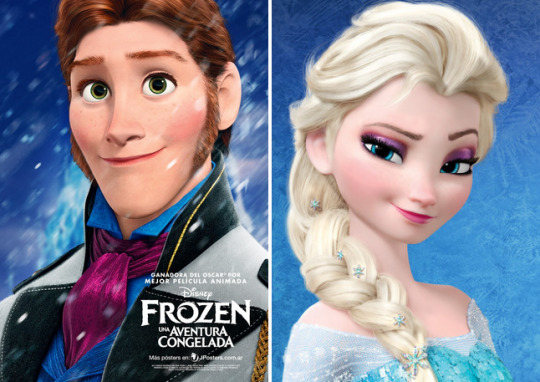
Who people think they are

Who they really are
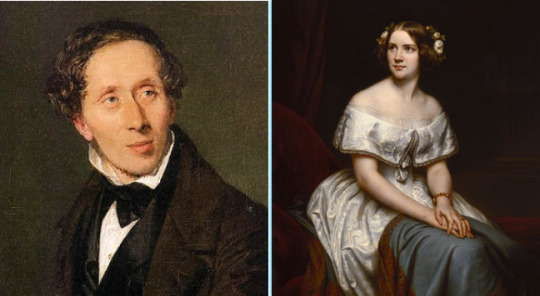
Conclusion
So... if I'm on the right track, and Disney created Prince Hans' character as a tribute to Hans Christian Andersen, wouldn't it make sense they planned to give him the happy ending he did not have in real life?
Time to analyze the Helsa hints...but that will be in a next post.
First post of these series here.
#frozen#disney#frozen analysis#hans analysis#hans#prince hans#hans of the southern isles#prince hans of the southern isles#hans frozen#let's redeem hans#my theories#who is this hans#disneyfilms#santino fontana#frozensource#elsa#queen elsa#elsa frozen#elsa disney#who is this elsa#elsa is a disney witch#frozen fever#the southern isles#fyn#fyn denmark#denmark#funen#funen denmark#egeskov castle#frozen disney
100 notes
·
View notes
Photo

Egeskov Castle, Europe’s best preserved Renaissance water castle, Fyn Island, Denmark
3 notes
·
View notes
Text

Hans Andersen Brendekilde (Danish painter) 1857 - 1942
A Young Woman Walks the Dog in an Autumn Forest, 1910
oil on canvas
88 x 78 cm. (34.65 x 30.71 in.)
signed and dated H. A. Brendekilde 1910
private collection
© photo Bruun Rasmussen
Hans Anderson Brendekilde was a nineteenth century Danish artist who excelled in a variety of media. He began his artistic life as a sculptor but in his maturity committed himself entirely to oils and pastel. His paintings are often on a very large scale creating delightful enveloping vistas of the beautiful Danish countryside. He painted evocative landscape paintings, harsh social realist subjects and dramatic depictions of religious subjects.
H. A. Brendekilde enrolled in the Copenhagen Academy as a sculpture student between 1870 and 1881. Between 1800 and 1900 he was involved in the realist debate in Danish art. He first exhibited in 1882 and was represented at Danish and international exhibitions, including the Worlds Colombian Fair, Chicago 1893, and the Exposition Universelle, Paris 1889. He was greatly influenced by the plein-air techniques and subjects matters of French Impressionism and inspired by naturalist, realist art. He almost always painted before the motif in nature, observing daily life and human life, only retouching his compositions in the final stages in the studio. Brendekilde applied the stylistic innovations of the French Impressionists to a personal and Danish subject matter.
About 1885 he started to paint large-scale works with landscapes and forests with white anemones and fresh green leaves, like The first anemones. With the photographic effect in the composition of landscapes and figures and the "rough" brushstrokes, Brendekilde elaborates a poetic representation of the harmony between nature and man.
Brendekilde exhibited regularly both in Denmark and throughout Europe. He was awarded annual medals both in 1892 for Spring and the following year for Une Route.
The work of Hans Anderson Brendekilde is represented in the Fyns Kunstmuseum, Odense, Denmark.
Source: Internet Antique Gazette
7 notes
·
View notes
Text
Odense
Odense is the third-largest city in Denmark and the main city on the island of Funen (Fyn). It’s a historically significant city with a rich cultural heritage, known for being the birthplace of the famed Danish author Hans Christian Andersen. Here’s a detailed look at Odense and its key features:
History and Cultural HeritageOdense has a long history that dates back over a thousand years. It was…
View On WordPress
0 notes
Text

Dive into the world of digital marketing in Denmark! From Randers to Fyn, Roskilde to Horsens, businesses are leveraging innovative strategies to thrive in today's competitive market. Discover how digital marketing is reshaping businesses across Denmark. #DigitalMarketing
0 notes
Text
Maximizing Online Presence: Tailored Digital Marketing and SEO Services in Randers, Fyn, and Roskilde
In today's digital age, businesses in Randers, Fyn, and Roskilde recognize the importance of establishing a strong online presence to remain competitive and connect with their target audience effectively. To achieve this, strategic digital marketing and search engine optimization (SEO) tactics tailored to each location are essential. Let's delve into how businesses in Randers, Fyn, and Roskilde can benefit from these specialized services:

Digital Marketing in Randers: Nestled along the banks of the Digital markedsføring Randers, Randers boasts a vibrant business community with diverse offerings. To stand out in this bustling city, businesses need to employ digital marketing strategies that resonate with the local audience. Our tailored approach to digital marketing in Randers includes targeted social media campaigns, engaging email newsletters, and compelling content creation. By connecting with the community through these channels, businesses can increase brand awareness, attract new customers, and foster lasting relationships.
Online Marketing in Fyn: As the third-largest island in Denmark, Fyn is renowned for its picturesque landscapes and rich cultural heritage. Businesses on Fyn can leverage the island's strong sense of community and local pride by implementing strategic online marketing initiatives. Our specialized services in Fyn focus on leveraging platforms like social media, search engines, and local directories to increase brand visibility and drive website traffic. Whether it's a small boutique shop or a large corporation, our Online markedsføring fyn are designed to help businesses connect with their target audience and achieve their marketing goals.
Best SEO Firm in Roskilde: With its historic charm and thriving business scene, Roskilde offers a wealth of opportunities for businesses to thrive. To ensure success in this competitive market, businesses need to invest in effective SEO strategies that improve their website's visibility and drive organic traffic. Our comprehensive SEO services in Roskilde encompass everything from keyword research and on-page optimization to link building and content creation. By implementing these strategies, businesses can enhance their online presence, increase website traffic, and attract qualified leads.
0 notes
Text
Egeskov Castle, Europe�s best preserved Renaissance water castle, Fyn Island, Denmark

0 notes